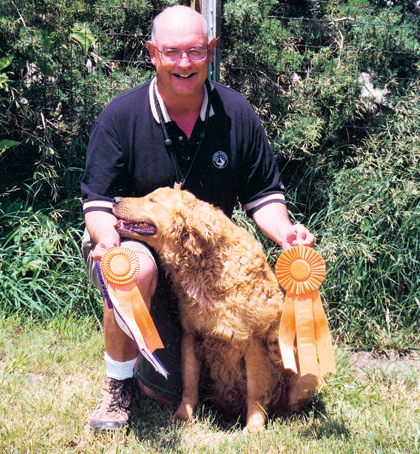The latest training techniques for pointing breeds retrievers and spaniels.
By James B. Spencer
"Some dog owners, in showing off for their buddies," Lonny said, "let their egos get out of hand. Once that happens, the guy can slip easily into a couple of bad mistakes. First, if his dog messes up somehow, as all dogs do, he blows his top, mostly to impress his buddies. Second, he might even expect his dog to do something he hasn't trained the poor animal to do, and when the dog fails, he blows his top, again mostly to impress their buddies.
 Lonny Taylor |
"In both cases, he over-corrects his dog, which can adversely affect the dog's attitude toward hunting. And he usually makes a bad impression on his buddies, as well."
On the other hand, Lonny said some dog owners become so caught up in hunting that they let their dogs get away with mistakes they wouldn't tolerate in training. Such inconsistency eventually teaches the dog that he can get away with things in hunting that are major no-no's in training.
"For example," he said, "many owners fall unconsciously into the habit of letting their dogs break as a bird falls rather than waiting to be sent to retrieve. If you want a steady retriever, you have to keep him steady all the time, not just in training."
Lonny stressed that you should prepare your dog for everything you expect him to encounter when hunting. If he's to sit some distance from the blind, you should have him do this in training. If he's to hunt from a boat, you should introduce him in training to whatever kinds of boats he will hunt from. Ditto for platforms, layout blinds, various decoy types, and so on. If you hunt with two or three hunters, you should give your retriever similar experiences in training.
"Hunting is no time for introducing your dog to anything new or unusual," he said. "When a client brings a retriever to me for gun dog training, I always quiz him about the kind of hunting he does, so I can introduce his dog to everything he needs to be comfortable with."
Lonny recommends that, if you train with an e-collar, you also use the e-collar while hunting, except in snag-infested waters, where it might hang up and could conceivably drown your dog.
"The e-collar has revolutionized retriever training and handling," he said. "but you should keep in mind that it's a reinforcement tool, not a method of revenge when you get angry with your dog. If you mis-correct or over-correct with the e-collar while hunting, you'll almost certainly diminish your dog's enthusiasm for performing while hunting."
Lonny said that if you hunt with non-dog-owning buddies, you should explain what you expect of them before scheduling the hunt. Ideally, they should attend a few of your training sessions, where you can both instruct them and evaluate their suitability.
If you hunt with other retriever owners, you should sit down with them before scheduling the hunt to discuss their wishes and yours. If you hit a show-stopper disagreement, it's better not to let the curtain go up than to open a flop.
"When hunting with other retrievers," Lonny said, "make sure the dogs get along. Dog fights don't enhance the hunt. Of course, the best time and place to introduce dogs to one another is during training sessions."
Lonny's final words: "Blend your training and hunting so completely that your dog hardly knows the difference."
RETRIEVERS
This tip is from Lonny Taylor of Taylor Made Retrievers, 10305 East Boundary Road, Mount Hope, KS 67108; (316) 259-2009; website: www.proretrievertraining.com; e-mail taylormaderetrievers@hotmail.com. Lonny has been training professionally for nine years, specializing in retrievers for hunting, hunting tests, and field trials. He has qualified dogs for and run them in the national open field trial championship. He has earned more than 120 hunting test title, placing one dog in the Master National Hall of Fame






